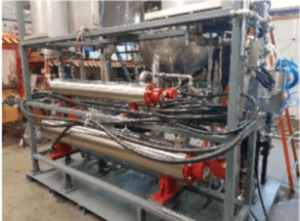An Introduction to Electric Circulation Heaters
Last updated on January 5th, 2024 at 09:47 pm
 Heating is a vital part of almost every industrial procedure. From oil refining to chemical manufacturing, heaters are used everywhere from Los Angeles California to Charlotte, North Carolina and for the most part, the design and specifications of heaters vary in accordance with the area of application. But there are some heaters that can be used in every industrial application and circulation heaters are one of these heaters. Unlike flanged heaters, electric circulation heaters are used to heat and compress fluids as well as gases.
Heating is a vital part of almost every industrial procedure. From oil refining to chemical manufacturing, heaters are used everywhere from Los Angeles California to Charlotte, North Carolina and for the most part, the design and specifications of heaters vary in accordance with the area of application. But there are some heaters that can be used in every industrial application and circulation heaters are one of these heaters. Unlike flanged heaters, electric circulation heaters are used to heat and compress fluids as well as gases.
Design
The physical design of a typical circulation heater seems quite similar to a simple tube exchanger, but beneath the surface there are a number of differences. Though both the exchange and circulation heaters have vessels where the fluid or gas to be heated is contained, a heat exchanger uses hot tubes through which the medium to be heated flows. A circulation heater, on the other hand, needs electric power to function. It has multiple heating elements and a thermostat to heat the fluid to the desired temperature.
Heat exchangers have two sides- the shell side and the tube side. As the name implies, heat exchangers work on the principle of transferring heat from the cold region (shell side) to the hot area (tube side). Electric circulation heaters have just one vessel. The heating element is directly immersed into the fluid or gas to be heated. The direct supply of heat also reduces energy losses that occur during hear transfer.
Circulation heaters are different from other electric heaters because the heating elements present in these heaters keep on circulating, which makes them suitable for all types of mediums (liquids and gases). Just like other electric heaters, circulation heaters also come in different sizes. Their power and voltage ratings also vary with their sizes.
Application
Electric circulation heaters, due to their design and efficiency, are used in a wide range of industrial applications. They are used to compress gases as well as for heating all types of fluids. Electric circulation heaters are used in the following industries:
- In oil refining industries, circulation heaters are used for removing precipitates.
- In petroleum and lubricant manufacturing, circulation heaters are used to compress large chains of hydrocarbons.
- Circulation heaters are used in gas mining and chemical manufacturing industries.
Circulation heaters, due to their easy operation and efficiency, have replaced traditional heat exchangers to a significant extent. They can perform all the functions that a simple tube heat exchanger does.
Technical Considerations
Here are some technical considerations you must keep in mind to ensure proper functioning of circulation heaters:
- Heating viscous and unrefined fluids can often lead to coking. To avoid this problem, regular greasing of moving parts is important.
- If the heater is installed vertically, make sure the enclosure temperature does not go too high-it can impact the functioning of internal limit sensors.
- Make sure all the sensing probes are working properly.
- Keep a regular check on internal wiring and insulation.
- Last but not least- avoid using silicone lubricant on active heating elements.
